Xiaolei Huang
A Survey on Long-Video Storytelling Generation: Architectures, Consistency, and Cinematic Quality
Jul 09, 2025Abstract:Despite the significant progress that has been made in video generative models, existing state-of-the-art methods can only produce videos lasting 5-16 seconds, often labeled "long-form videos". Furthermore, videos exceeding 16 seconds struggle to maintain consistent character appearances and scene layouts throughout the narrative. In particular, multi-subject long videos still fail to preserve character consistency and motion coherence. While some methods can generate videos up to 150 seconds long, they often suffer from frame redundancy and low temporal diversity. Recent work has attempted to produce long-form videos featuring multiple characters, narrative coherence, and high-fidelity detail. We comprehensively studied 32 papers on video generation to identify key architectural components and training strategies that consistently yield these qualities. We also construct a comprehensive novel taxonomy of existing methods and present comparative tables that categorize papers by their architectural designs and performance characteristics.
Examining and Adapting Time for Multilingual Classification via Mixture of Temporal Experts
Feb 12, 2025Abstract:Time is implicitly embedded in classification process: classifiers are usually built on existing data while to be applied on future data whose distributions (e.g., label and token) may change. However, existing state-of-the-art classification models merely consider the temporal variations and primarily focus on English corpora, which leaves temporal studies less explored, let alone under multilingual settings. In this study, we fill the gap by treating time as domains (e.g., 2024 vs. 2025), examining temporal effects, and developing a domain adaptation framework to generalize classifiers over time on multiple languages. Our framework proposes Mixture of Temporal Experts (MoTE) to leverage both semantic and data distributional shifts to learn and adapt temporal trends into classification models. Our analysis shows classification performance varies over time across different languages, and we experimentally demonstrate that MoTE can enhance classifier generalizability over temporal data shifts. Our study provides analytic insights and addresses the need for time-aware models that perform robustly in multilingual scenarios.
Examining Imbalance Effects on Performance and Demographic Fairness of Clinical Language Models
Dec 23, 2024
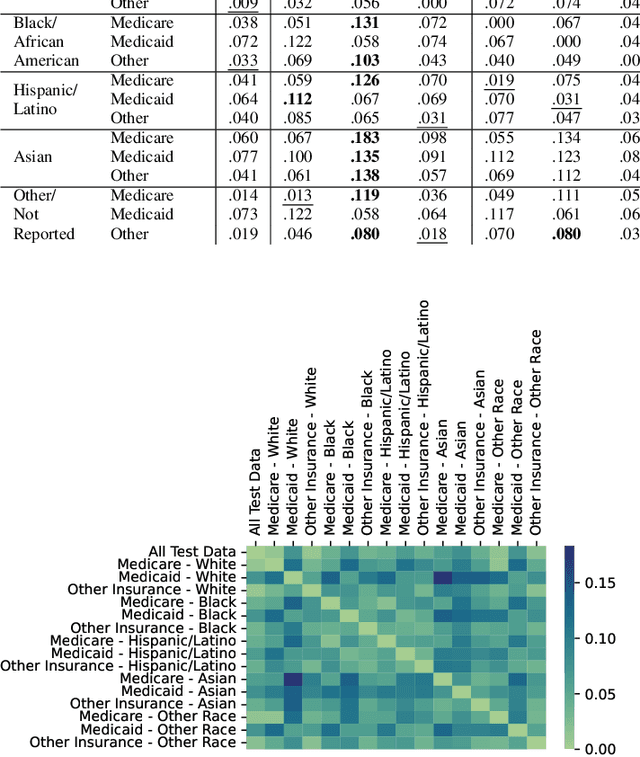


Abstract:Data imbalance is a fundamental challenge in applying language models to biomedical applications, particularly in ICD code prediction tasks where label and demographic distributions are uneven. While state-of-the-art language models have been increasingly adopted in biomedical tasks, few studies have systematically examined how data imbalance affects model performance and fairness across demographic groups. This study fills the gap by statistically probing the relationship between data imbalance and model performance in ICD code prediction. We analyze imbalances in a standard benchmark data across gender, age, ethnicity, and social determinants of health by state-of-the-art biomedical language models. By deploying diverse performance metrics and statistical analyses, we explore the influence of data imbalance on performance variations and demographic fairness. Our study shows that data imbalance significantly impacts model performance and fairness, but feature similarity to the majority class may be a more critical factor. We believe this study provides valuable insights for developing more equitable and robust language models in healthcare applications.
Time Matters: Examine Temporal Effects on Biomedical Language Models
Jul 24, 2024



Abstract:Time roots in applying language models for biomedical applications: models are trained on historical data and will be deployed for new or future data, which may vary from training data. While increasing biomedical tasks have employed state-of-the-art language models, there are very few studies have examined temporal effects on biomedical models when data usually shifts across development and deployment. This study fills the gap by statistically probing relations between language model performance and data shifts across three biomedical tasks. We deploy diverse metrics to evaluate model performance, distance methods to measure data drifts, and statistical methods to quantify temporal effects on biomedical language models. Our study shows that time matters for deploying biomedical language models, while the degree of performance degradation varies by biomedical tasks and statistical quantification approaches. We believe this study can establish a solid benchmark to evaluate and assess temporal effects on deploying biomedical language models.
Length-Aware Multi-Kernel Transformer for Long Document Classification
May 11, 2024Abstract:Lengthy documents pose a unique challenge to neural language models due to substantial memory consumption. While existing state-of-the-art (SOTA) models segment long texts into equal-length snippets (e.g., 128 tokens per snippet) or deploy sparse attention networks, these methods have new challenges of context fragmentation and generalizability due to sentence boundaries and varying text lengths. For example, our empirical analysis has shown that SOTA models consistently overfit one set of lengthy documents (e.g., 2000 tokens) while performing worse on texts with other lengths (e.g., 1000 or 4000). In this study, we propose a Length-Aware Multi-Kernel Transformer (LAMKIT) to address the new challenges for the long document classification. LAMKIT encodes lengthy documents by diverse transformer-based kernels for bridging context boundaries and vectorizes text length by the kernels to promote model robustness over varying document lengths. Experiments on five standard benchmarks from health and law domains show LAMKIT outperforms SOTA models up to an absolute 10.9% improvement. We conduct extensive ablation analyses to examine model robustness and effectiveness over varying document lengths.
Chain-of-Interaction: Enhancing Large Language Models for Psychiatric Behavior Understanding by Dyadic Contexts
Mar 23, 2024
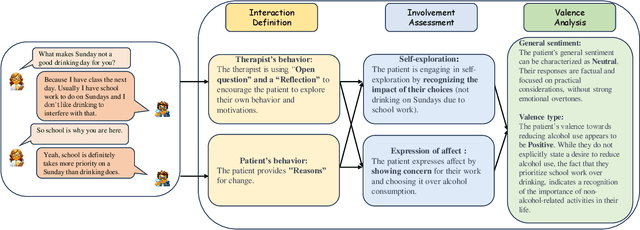


Abstract:Automatic coding patient behaviors is essential to support decision making for psychotherapists during the motivational interviewing (MI), a collaborative communication intervention approach to address psychiatric issues, such as alcohol and drug addiction. While the behavior coding task has rapidly adapted machine learning to predict patient states during the MI sessions, lacking of domain-specific knowledge and overlooking patient-therapist interactions are major challenges in developing and deploying those models in real practice. To encounter those challenges, we introduce the Chain-of-Interaction (CoI) prompting method aiming to contextualize large language models (LLMs) for psychiatric decision support by the dyadic interactions. The CoI prompting approach systematically breaks down the coding task into three key reasoning steps, extract patient engagement, learn therapist question strategies, and integrates dyadic interactions between patients and therapists. This approach enables large language models to leverage the coding scheme, patient state, and domain knowledge for patient behavioral coding. Experiments on real-world datasets can prove the effectiveness and flexibility of our prompting method with multiple state-of-the-art LLMs over existing prompting baselines. We have conducted extensive ablation analysis and demonstrate the critical role of dyadic interactions in applying LLMs for psychotherapy behavior understanding.
Semantic-Aware Transformation-Invariant RoI Align
Dec 15, 2023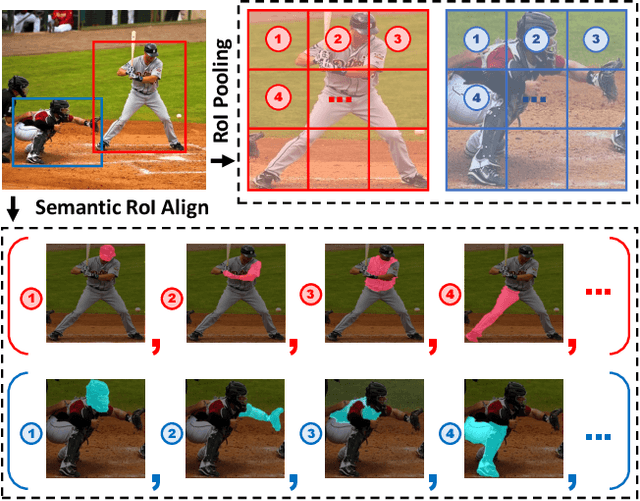

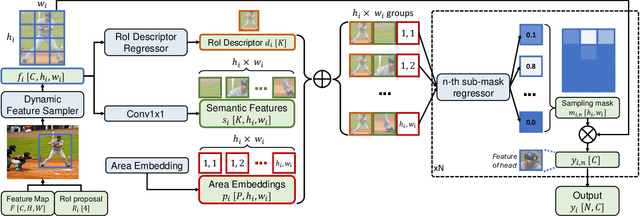
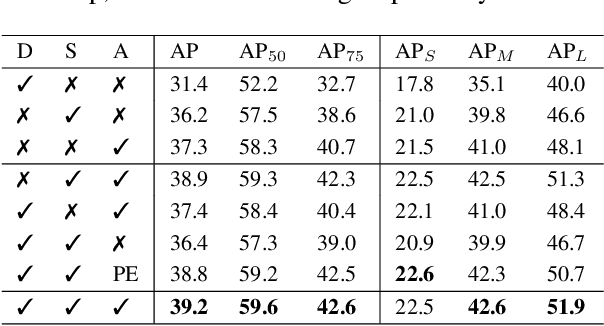
Abstract:Great progress has been made in learning-based object detection methods in the last decade. Two-stage detectors often have higher detection accuracy than one-stage detectors, due to the use of region of interest (RoI) feature extractors which extract transformation-invariant RoI features for different RoI proposals, making refinement of bounding boxes and prediction of object categories more robust and accurate. However, previous RoI feature extractors can only extract invariant features under limited transformations. In this paper, we propose a novel RoI feature extractor, termed Semantic RoI Align (SRA), which is capable of extracting invariant RoI features under a variety of transformations for two-stage detectors. Specifically, we propose a semantic attention module to adaptively determine different sampling areas by leveraging the global and local semantic relationship within the RoI. We also propose a Dynamic Feature Sampler which dynamically samples features based on the RoI aspect ratio to enhance the efficiency of SRA, and a new position embedding, \ie Area Embedding, to provide more accurate position information for SRA through an improved sampling area representation. Experiments show that our model significantly outperforms baseline models with slight computational overhead. In addition, it shows excellent generalization ability and can be used to improve performance with various state-of-the-art backbones and detection methods.
Token Imbalance Adaptation for Radiology Report Generation
Apr 18, 2023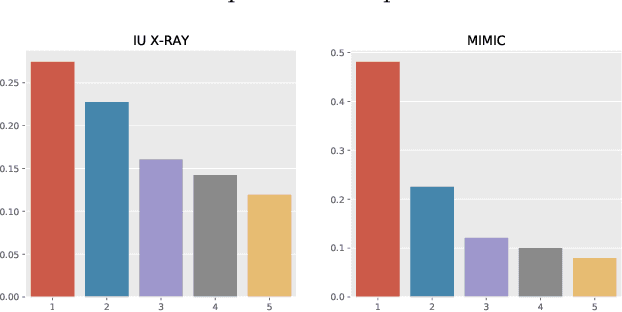

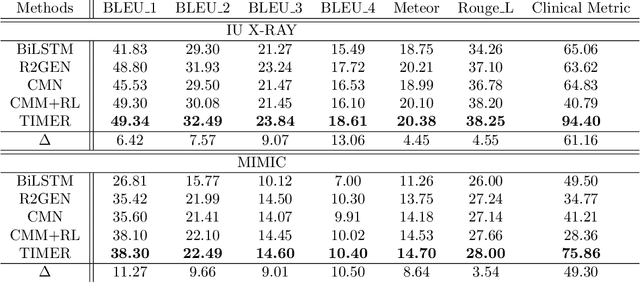
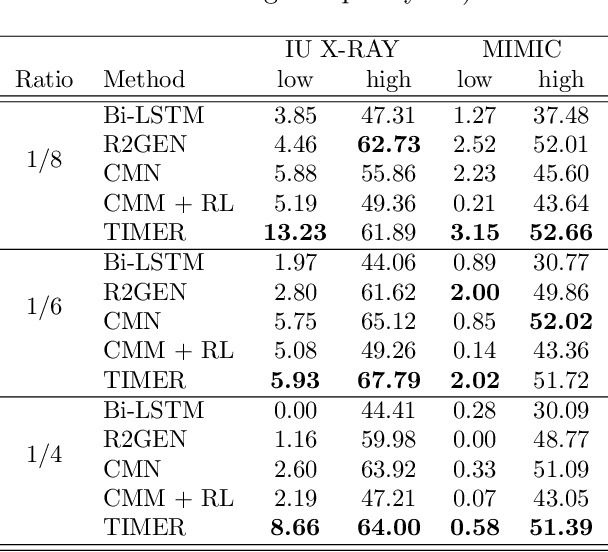
Abstract:Imbalanced token distributions naturally exist in text documents, leading neural language models to overfit on frequent tokens. The token imbalance may dampen the robustness of radiology report generators, as complex medical terms appear less frequently but reflect more medical information. In this study, we demonstrate how current state-of-the-art models fail to generate infrequent tokens on two standard benchmark datasets (IU X-RAY and MIMIC-CXR) of radiology report generation. % However, no prior study has proposed methods to adapt infrequent tokens for text generators feeding with medical images. To solve the challenge, we propose the \textbf{T}oken \textbf{Im}balance Adapt\textbf{er} (\textit{TIMER}), aiming to improve generation robustness on infrequent tokens. The model automatically leverages token imbalance by an unlikelihood loss and dynamically optimizes generation processes to augment infrequent tokens. We compare our approach with multiple state-of-the-art methods on the two benchmarks. Experiments demonstrate the effectiveness of our approach in enhancing model robustness overall and infrequent tokens. Our ablation analysis shows that our reinforcement learning method has a major effect in adapting token imbalance for radiology report generation.
Semi-supervised Body Parsing and Pose Estimation for Enhancing Infant General Movement Assessment
Oct 14, 2022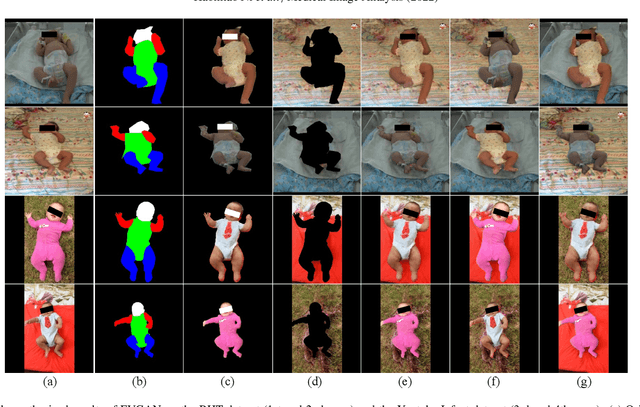
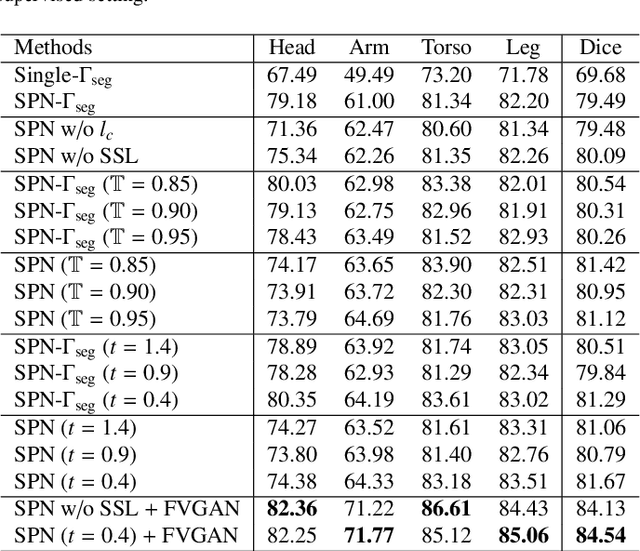
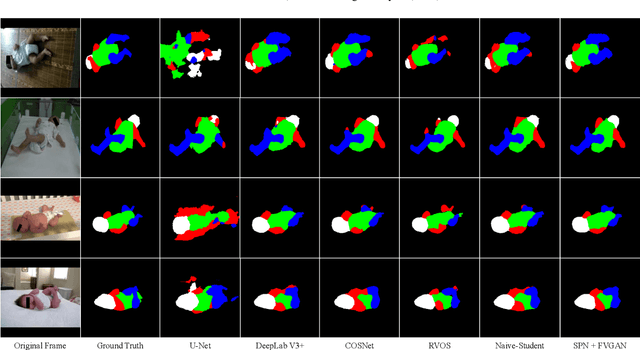

Abstract:General movement assessment (GMA) of infant movement videos (IMVs) is an effective method for early detection of cerebral palsy (CP) in infants. We demonstrate in this paper that end-to-end trainable neural networks for image sequence recognition can be applied to achieve good results in GMA, and more importantly, augmenting raw video with infant body parsing and pose estimation information can significantly improve performance. To solve the problem of efficiently utilizing partially labeled IMVs for body parsing, we propose a semi-supervised model, termed SiamParseNet (SPN), which consists of two branches, one for intra-frame body parts segmentation and another for inter-frame label propagation. During training, the two branches are jointly trained by alternating between using input pairs of only labeled frames and input of both labeled and unlabeled frames. We also investigate training data augmentation by proposing a factorized video generative adversarial network (FVGAN) to synthesize novel labeled frames for training. When testing, we employ a multi-source inference mechanism, where the final result for a test frame is either obtained via the segmentation branch or via propagation from a nearby key frame. We conduct extensive experiments for body parsing using SPN on two infant movement video datasets, where SPN coupled with FVGAN achieves state-of-the-art performance. We further demonstrate that SPN can be easily adapted to the infant pose estimation task with superior performance. Last but not least, we explore the clinical application of our method for GMA. We collected a new clinical IMV dataset with GMA annotations, and our experiments show that SPN models for body parsing and pose estimation trained on the first two datasets generalize well to the new clinical dataset and their results can significantly boost the CRNN-based GMA prediction performance.
End-to-end Graph-constrained Vectorized Floorplan Generation with Panoptic Refinement
Jul 27, 2022

Abstract:The automatic generation of floorplans given user inputs has great potential in architectural design and has recently been explored in the computer vision community. However, the majority of existing methods synthesize floorplans in the format of rasterized images, which are difficult to edit or customize. In this paper, we aim to synthesize floorplans as sequences of 1-D vectors, which eases user interaction and design customization. To generate high fidelity vectorized floorplans, we propose a novel two-stage framework, including a draft stage and a multi-round refining stage. In the first stage, we encode the room connectivity graph input by users with a graph convolutional network (GCN), then apply an autoregressive transformer network to generate an initial floorplan sequence. To polish the initial design and generate more visually appealing floorplans, we further propose a novel panoptic refinement network(PRN) composed of a GCN and a transformer network. The PRN takes the initial generated sequence as input and refines the floorplan design while encouraging the correct room connectivity with our proposed geometric loss. We have conducted extensive experiments on a real-world floorplan dataset, and the results show that our method achieves state-of-the-art performance under different settings and evaluation metrics.
 Add to Chrome
Add to Chrome Add to Firefox
Add to Firefox Add to Edge
Add to Edge